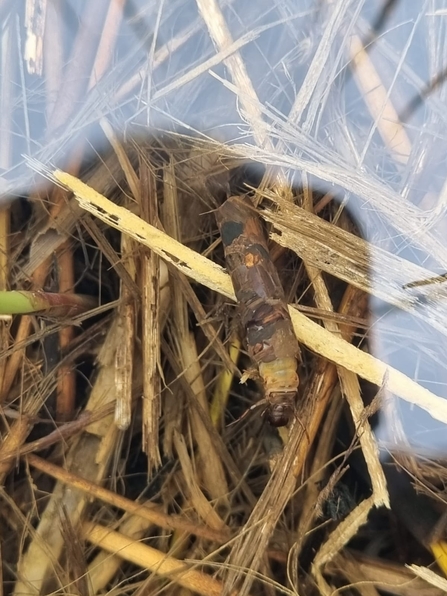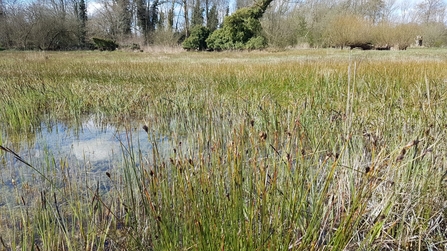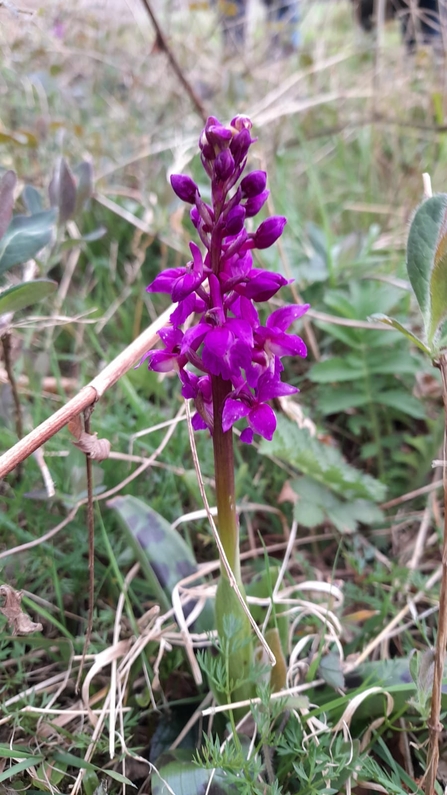Weekly wild news from our reserves – 14 April 2022
Hen Reedbeds - Jamie Smith
The North East reserve team were extremely grateful for this curry donation whilst working hard installing gates and new crossings at Dingle Marshes. Big thanks to Lowestoft Tandoori for their kindness and generosity!
During work they were excited to find this ancient marmalade jar. Dating from 1862 this is likely to be a piece from a Keiller’s marmalade jar. Keiller’s marmalade is thought to be the first marmalade produced in the UK with the company being based in Dundee.
Caddisfly construction
Caddisfly larvae live underwater, where they make cases by spinning together stones, sand, leaves and twigs with a silk they secrete from glands around the mouth. Most larvae live in these shelters, which can either be fixed or transportable, though a few species are free-swimming and only construct shelters when they’re ready to pupate. Adult caddisflies resemble moths, but with their wings folded back along the body. Unlike moths, they have a fine set of hairs on their wings instead of scales.

Caddisfly larvae at Lackford Lakes – Joe Bell-Tye
Willow warbler warbling
Warden Dan managed to record the lovely melody of the willow warbler in this clip from Darsham Marshes. Willow warblers are migratory birds, breeding in Europe and migrating to southern Africa for the winter. They are unusual birds because they moult all their feathers twice a year - once at their breeding grounds and once at their wintering grounds; yet, the reason for this is unclear. Like other warblers, they are insectivorous, but will eat berries and fruit in autumn.
Miniature beauties
Warden Joe has been admiring the smaller wonders at Lackford Lakes this week, a scarlet elfcup fungus and a tiny early forget-me-not. The scarlet elfcup can be seen in late winter and early spring on fallen twigs and branches (often hazel, elm and willow), usually buried under moss.
As its name suggests, the early forget-me-not flowers early in spring and has minute blue flowers.
Spring wonders at Arger Fen
Arger Fen is wonderful in spring! This week Warden Joe recorded barren strawberry, wood anemones, wild cherry in blossom, early dog violets, cowslips and bluebells just starting to flower.
Fabulous peaty fens
Thelnetham Fen is looking stunning, especially looking across to the LOHP (Little Ouse Headwaters Project) part of fen where they have worked hard to restore the open fen habitats. It now looks like one continuous fen. The photo below shows black bog rush (Schoenus nigricans) in foreground, a fabulous black-flowered sedge which is characteristic of peaty fens.

Thelnetham Fen black bog rush - Debs Crawford
Early purple orchid
This vivid beauty lives up to its name – the early purple orchid at Bradfield Woods.

Early purple orchid – Alex Lack
Dawn spring survey
Warden Jamie took these gorgeous photos whilst completing his first spring dawn survey at Hen Reedbeds. Species recorded included booming bitterns, displaying marsh harriers and pinging bearded tits, and these lovely cowslips.
Cuckooflower
Cuckooflower, also commonly known as 'lady's-smock', is a pretty, springtime perennial of damp, grassy places like wet meadows, ditches and riverbanks, like this one at Church Farm Marshes. Its pale pink flowers bloom from April to June and are thought to coincide with the arrival of the first Cuckoo - a sure sign that spring has arrived.

Cuckoo flower at Church Farm Marshes – Jamie Smith
Moody skies
Warden Debs snapped this atmospheric sky at Redgrave and Lopham Fen this week, - certainly looks like an April shower on the way!
Redgrave – Debs Crawford















